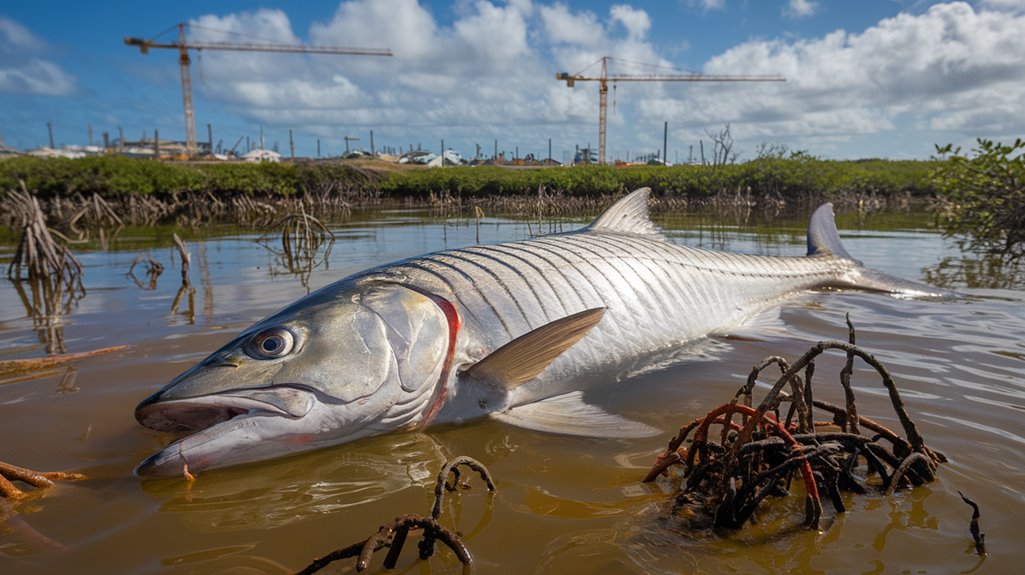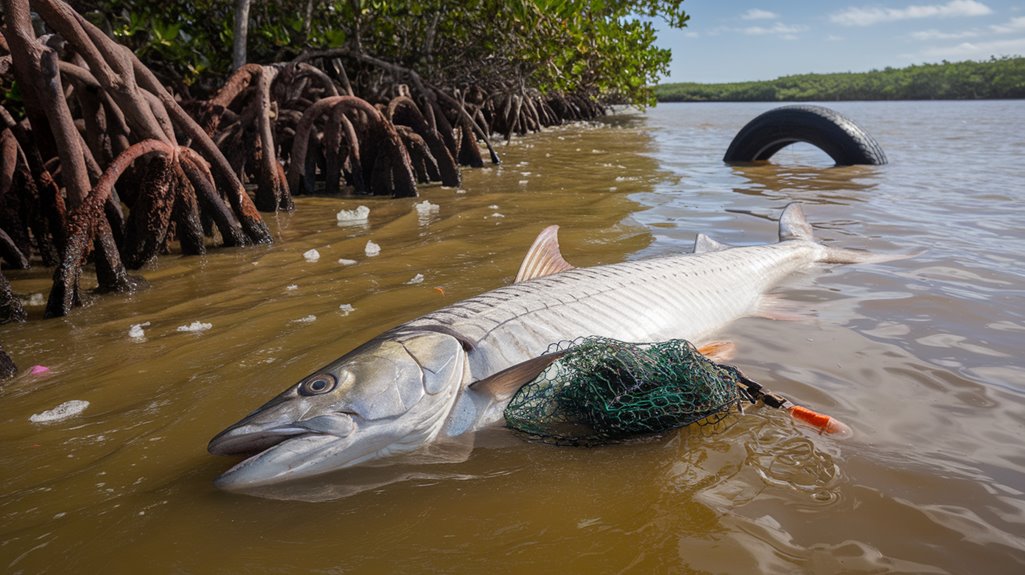In a world where every coastal ecosystem hangs by a thread, you'll find tarpon struggling against unprecedented environmental pressures. These ancient fish, which have survived for over 100 million years, now face a perfect storm of habitat destruction and water quality degradation. While you're likely familiar with general marine pollution issues, the specific combination of factors threatening tarpon populations presents a unique case study in how human activities transform essential ecosystems. Understanding these impacts holds the key to preventing their decline.
Key Takeaways
- Nutrient pollution causes algal blooms that deplete oxygen levels, creating dead zones where tarpon cannot survive.
- Loss of over 2 million acres of seagrass severely reduces essential nursery habitat for juvenile tarpon.
- Mangrove habitat decline of more than 50% eliminates crucial protective areas for tarpon development and feeding.
- Degradation of estuarine environments disrupts spawning patterns and early life stages of tarpon.
- Agricultural runoff and outdated sewage systems contaminate coastal waters, compromising tarpon's clean water requirements.
Understanding Tarpon Biology and Habitat Requirements
While tarpon populations face numerous environmental challenges, understanding their biological requirements and habitat preferences is essential for effective conservation efforts. You'll find these magnificent fish, which can reach lengths of 8 feet and weights over 280 pounds, thriving in warm coastal waters where clean water and healthy habitats support their lifecycle. Tarpon depend significantly on seagrass beds and mangrove ecosystems, which provide vital nursery areas for juveniles and abundant prey species. These habitats offer protection and food sources, particularly for young tarpon that require shallow waters rich in small fish and crustaceans. However, habitat loss, harmful algal blooms, and deteriorating water quality threaten their survival. The species' reliance on both freshwater and marine environments makes them particularly vulnerable to ecosystem degradation across multiple habitat types.
Major Threats to Water Quality Affecting Tarpon
The deteriorating water quality in Florida's coastal ecosystems poses multiple direct threats to tarpon populations. You'll find excessive nutrient pollution triggering widespread algae blooms, which deplete oxygen levels and create dead zones where fish populations can't survive. Water flowing patterns have been disrupted by development, severely impacting the healthy habitats tarpon need for spawning and juvenile development.
- Nutrient pollution from agricultural runoff and outdated sewage systems has triggered devastating HABs
- Loss of over 2 million acres of seagrass has reduced habitat available for juvenile tarpon
- Altered freshwater flows have degraded essential estuarine environments
- Coastal waters suffer from loss and degradation of mangroves and oyster reefs, reducing food sources
These negative impacts have led to measurable declines in both harvested and catch-and-release tarpon species, indicating serious ecosystem-wide challenges.
Critical Habitat Loss and Its Consequences
As mangrove habitats across Florida's coastline have declined by more than 50%, tarpon populations face unprecedented challenges in maintaining their historical abundance. You'll find the impact of habitat loss particularly severe in critical nursery areas where juvenile fish development occurs. The combination of altered freshwater flows and deteriorating ecological balance has created a cascade of negative effects.
| Habitat Type | Loss Impact |
|---|---|
| Mangroves | >50% decline |
| Seagrass | 33% reduction |
| Oyster Reefs | 80% loss |
| Freshwater Flow | Severely altered |
The degradation of these interconnected ecosystems has diminished essential food sources and protective areas for tarpon. Without immediate restoration efforts, you're likely to witness continued decline in tarpon populations, particularly as coastal mangrove loss accelerates and water quality issues persist.
Economic Value of Healthy Tarpon Populations
Generating billions in annual revenue, Florida's recreational fishing industry heavily depends on thriving tarpon populations, with data showing approximately $27 billion in economic impact through tourism and related activities. The economic value of healthy tarpon populations extends beyond direct fishing revenue, supporting multiple sectors and local economies throughout the state.
Key economic impacts of tarpon conservation:
- Sustains thousands of jobs in hospitality, retail, and professional guiding services
- Preserves Florida's cultural fishing heritage, attracting tourists year-round
- Maintains property values in coastal communities dependent on recreational fishing
- Generates sustained revenue through conservation-based tourism activities
Water quality improvements and habitat restoration are essential investments for protecting these economic benefits, as pollution and habitat loss directly threaten the financial stability of fishing-dependent communities.
Conservation Strategies for Tarpon Recovery

While tarpon populations face mounting environmental pressures, extensive conservation strategies have emerged to support their recovery across multiple ecosystems. You'll find that successful tarpon recovery hinges on protecting and restoring vital seagrass and mangrove habitats where juvenile fish develop. Organizations like the Bonefish & Tarpon Trust are integrating habitat conservation with fisheries management through bag limits and seasonal closures, ensuring population sustainability.
Water quality improvements are essential to these efforts. You'll need to address nutrient runoff through enhanced sewage infrastructure and agricultural practices to protect tarpon habitats. Ongoing monitoring and research help adapt conservation strategies to environmental changes, while collaboration between stakeholders strengthens the effectiveness of recovery initiatives. These combined approaches create a thorough framework for sustaining tarpon populations and their essential ecosystems.
Frequently Asked Questions
How Do Pollution and Destruction of Habitat That Result From Aquaculture Impact Marine Environments?
You'll find that aquaculture's nutrient pollution triggers harmful algal blooms, while facility construction destroys essential marine habitats. The polluted runoff increases diseases, disrupts food webs, and degrades water quality systemwide.
What Is the Atlantic Tarpon Habitat?
Like ancient mariners, you'll find Atlantic tarpon in coastal waters, estuaries, and lagoons. They thrive in seagrass beds and mangrove forests, moving between freshwater and saltwater environments throughout their lifecycle.
Conclusion
You'll find that protecting tarpon populations is as essential as safeguarding the foundation of a building. The data demonstrates that water quality degradation and habitat loss directly correlate with declining tarpon numbers, impacting $6.1 billion in annual recreational fishing revenue. By implementing science-based conservation measures and restoring important ecosystems, you're not just preserving tarpon populations but securing significant economic and ecological benefits for coastal communities.

